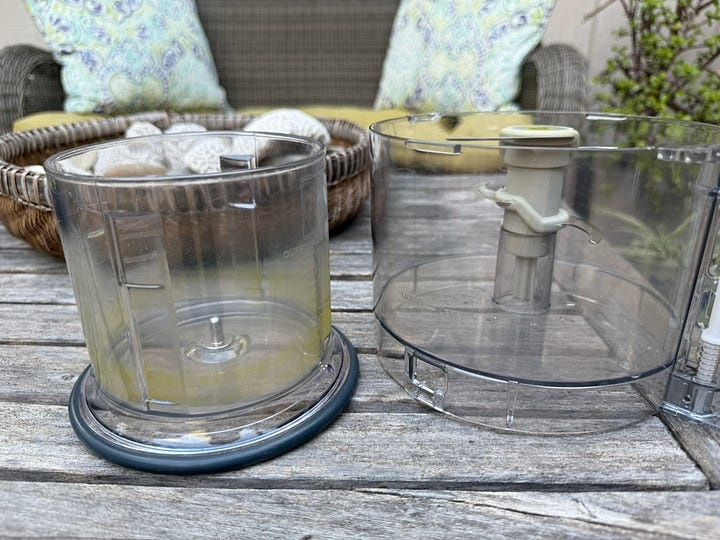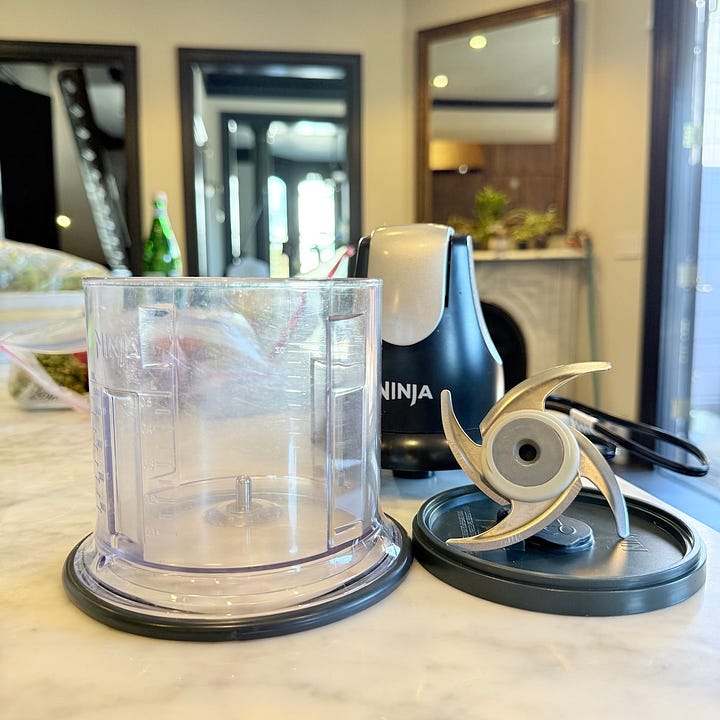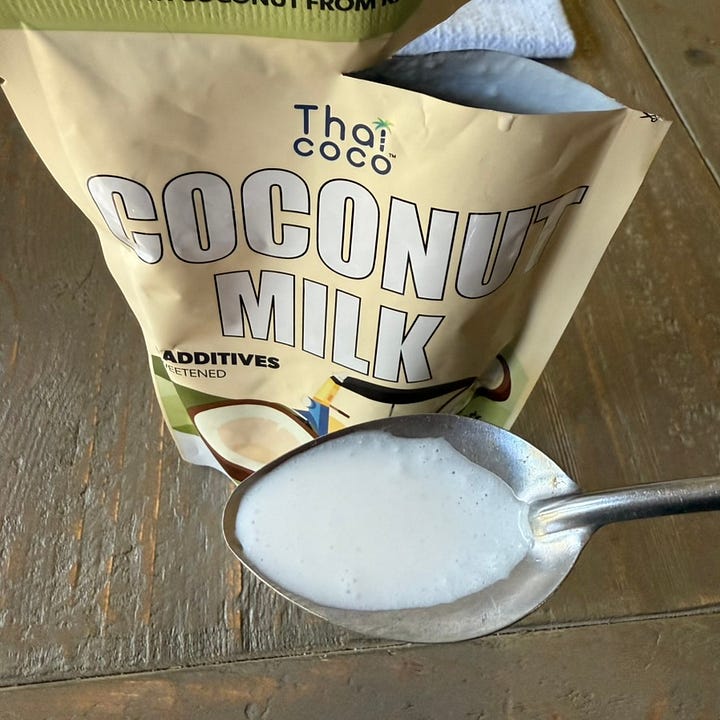midweek gems #40
+ mighty mini chopper + removing turmeric stains + nearly-fresh coconut milk
Hello everyone!
We’re closing in on finishing our two-week Cooking Thai photoshoot and the images are stunning. The cookbook project has taught so much about building excellent Thai flavors and we can’t wait to unleash it into the world.
Three recent discoveries and realizations reminded me that there’s always more to learn.
💎 Small hybrid processor-blender
From “Neverstick” cookware to ice cream machines that can make two flavors at once, Ninja appliances seem too good to be true. I’ve been reluctant to try Ninja products until Alex, a great home cook and volunteer tester for my book projects, mentioned the Ninja mini chopper for handling lemongrass and the like.
Most mini choppers (aka mini food processors) lack power to handle much more than say, tomato for salsa. Alex makes a lot of Southeast Asian food and said he liked the Ninja Express Chop (NEC) because it functions more like a hybrid blender-processor. I was intrigued, even though the two-level blade design scared me a bit. Was it easy to wash or would clumsy me cut myself?
I’ve used the NEC for two months now for small jobs like smooth purees and coarsely chopped onion. The big test was the kroeung seasoning paste loaded with fibrousy lemongrass and tough galangal. The NEC quickly blitzed those ingredients to a very fine texture. I also own Cuisinart and KitchenAid mini choppers, and those would not have done the job as well as the NEC on the kroeung. The other machines are good for tasks like uniformly chopping onion.
Ninja Express Chop positives:
NEC lives up the the “express” part of its name. Before you know it, the machine will go from coarsely chopping to chopping and then mincing your ingredients. Remember to pulse so you can monitor progress well.
The two-level blade is well proportioned with the container, allowing the unit to efficiently chop and grind ingredients.
It’s not hard to safely clean. Whirl a drop of dish soap and about 1 inch of water. Clean the nooks and crannies with a skewer tip and paper towel.
The unit seems flimsy because its engine is on top. But that actually means the engine won’t heat up the food being blitzed in the container at the bottom. The upside down design is pretty clever!
The blade, bowl, and lid can be affordably replaced.
Ninja Express Chop quirks:
When the NEC makes a funny “eychhhh” noise, that doesn’t mean it’s not working or about to blow its motor. You just need to pause and stir.
The machine works best if the lid is attached to the bottom container so the blade is securely attached. Forget to put the lid on and you’ll be sorry. The motor housing gets dirty.
It looks rickety and is loud but it gets the job done.
Summary: If you’re looking for a mighty little workhorse for purees and pastes, give the Ninja Express Chop a whirl.
💎 Passive solar cleaning
So… playing around with the kroeung and the Ninja Express Chop, I majorly stained the its container and my food processor bowl. The NEC’s container got a deep yellow ring; the processor bowl turned pale blond.
I typically wait and hope that future usage and washing will remove the stain. This time, I Googled for help.
As suggested on the Vitamix site, I tried a long soak in diluted vinegar. That did nothing to remove the turmeric stain.
I then skeptically tried a different method: leaving the plastic containers in the sun to bleach out the stain. After 3 days in the sun, the containers were no longer yellow! Restored.
That solar power cleaning tip, also from the Vitamix site, worked like a dream. No effort on my part. I left it all to Mother Nature. I turned the NEC blade upside down in the sun and the bits of yellow on the underside also faded back to the original grey!


Shazam. Any insights on removing stains from the blender or processor? Do tell!
💎 Nearly-like-fresh coconut milk
Coconut milk is practically the dairy of Southeast Asia. I have grated mature coconut flesh, massaged it in water, and then squeezed out the milky liquid. Trouble is, the coconuts we get in America are not fatty or tasty enough to be coconut milk quality. In Southeast Asia, fresh coconut milk tastes rich with a touch of natural sweetness.
Shopping at Ralph’s in Southern California, I spotted pouches of coconut milk and cream by Thai Coco. The packaging reminded me of what I’d seen at a Southeast Asian food expo in Bangkok.
What about the flavor? It was surprisingly excellent, with a close-to-fresh flavor. It wasn’t soapy tasting like some canned coconut milk. And, there is no emulsifier (guar gum, etc.), which producers often used to prevent the milk from separating too much.


How was it in cooking? I used Thai Coco milk for a chicken stir-fry (recipe coming this weekend!) and the flavor was a touch softer, sweeter, and deeper than when prepared with canned coconut milk.
The packaging says the coconuts come from Rachaburi Province in Thailand but from the company’s website, I can’t tell if there’s a specific kind of coconut used. It’s unclear what’s behind the great flavor of this coconut milk but it is some of the best commercially-produced coconut milk I’ve tasted in the States.
How to buy Thai Coco coconut milk: Head to a Kroger market or order from the company website, where a 6-pack of pouches or cans sells for about $25. Share your thoughts. I’ve not yet tried the coconut cream.
Coming up on Sunday is a Vietnamese lemongrass chicken stir-fry recipe that I didn’t think I could improve until I did. Signing off because it’s been a really long day . . .






I use powdered coconut milk. It keeps forever (sort of) and I can easily control the taste and thickness of the reconstituted milk.
I’ve looked at mini choppers for awhile now and just couldn’t decide which one to buy. My kitchen is very small and is short on storage space. But if the Ninja handled the krogeun seasoning paste, I’m sold. Now I can organize a trip to the Asian grocery store for lemon grass to make this paste!